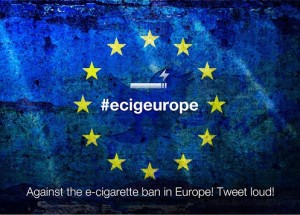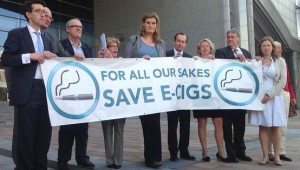In 2016 vaping is set to change in the UK. Upcoming regulation and restrictions mean that the way you vape will almost certainly be affected. There are 2 separate routes that electronic cigarettes can be regulated under: as tobacco products under the EU Tobacco Products Directive and as medical products with licencing from the MHRA. We have compiled all the facts you need to know about electronic cigarette UK regulation in 2016 and how it will affect us all.
There is an update to this article here: TPD Vaping Laws UK – 2017 Regulations
The 2014 Tobacco Products Directive (TPD)
 The first EU Tobacco Products Directive was released back in 2001. It’s main goal was to reduce tobacco usage across Europe especially for the younger generation. In 2014, behind closed doors it was decided to add electronic cigarettes to this directive to allow regulation of these devices by classifying them as tobacco related products. After several failed attempts to get a majority to agree on the new revision to include e-cigs, these new regulations were bundled with several other proposals such as plain packaging, tighter age restrictions and larger health warnings for tobacco cigarettes to finally get enough votes for it to pass.
The first EU Tobacco Products Directive was released back in 2001. It’s main goal was to reduce tobacco usage across Europe especially for the younger generation. In 2014, behind closed doors it was decided to add electronic cigarettes to this directive to allow regulation of these devices by classifying them as tobacco related products. After several failed attempts to get a majority to agree on the new revision to include e-cigs, these new regulations were bundled with several other proposals such as plain packaging, tighter age restrictions and larger health warnings for tobacco cigarettes to finally get enough votes for it to pass.
The newly revised Tobacco Products Directive proposes to regulate e-cigarettes as a tobacco related product. These new rules set to be implemented across EU member states will specify how tobacco related products (included e-cigs) can be sold, presented and manufactured. The new directive will come into force on the 20th May 2016.
Some of the new rules that the TPD require all member states (including the UK) to abide by include:
Say goodbye to “normal” size containers and buying in larger sizes to reduce cost. Apparently this is to reduce the chance of accidental poisoning although you can still buy a 2 litre bottle of lemon bleach from your supermarket.
This means the end of large tanks that many people now use. It is hard to see any justification to support this restriction.
No more 24mg strength – the high strength that a lot of people start off with to transition from tobacco. Apparently again due to poisoning concerns which have been proven to be totally false.
How this is interpreted could make or break e-cigs. No current device can provide a consistant dose as you can draw for as little or as long or as hard as you want. Not even tobacco cigarettes have to comply to this unworkable requirement.
Again how this is interpreted will determine how damaging it will be. No current system can ensure leak free refilling as this is largely down to the user. Although why this should be an issue is unknown, any e-cig user is used to a little bit of leaking and learns how to deal with it.
If 3 member states prohibit a product this can then be extended to all EU member states, in other words a blanket wide EU ban.
On top of the restrictions on products there is plenty of unnecessary red tape and requirements for manufacturers and distributors to comply with.
Anyone manufacturing or selling e-cigs must notify and submit information to their member state for each and every product, or product variation that they wish to sell. This includes ingredients lists, detailed emissions data, toxicological data, information on nicotine doses and absorption data, opening and refilling mechanisms and production processes for every single product variation that they wish to sell. Every year data on sales volumes, product types, consumer preferences and surveys must be submitted to member states. This will only increase cost which will ultimately have to be passed on to the consumer making e-cigs less attractive.
Back of a Fag Packet Regulation
Critics of the TPD have taken issue with the fact that some of the proposed regulations for E-cigarettes are unjustifiable when you consider the regulations that apply to normal cigarettes. It will also stifle the growth of this incredibly insurgent and potentially life-saving alternative to harmful tobacco smoke.
Martin Callanan, the leader of the European Conservatives and Reformists (ECR) group, said the legislation was too prescriptive.
E-cigarette’s are surely far better for you than smoking tobacco. We have fought for sensible regulation on e-cigs that recognises the role they have played in taking many thousands of people off of smoking.
The parliament voted for e-cigs to be lightly regulated until we know what regulation might be required. Yet MEPs and commission officials sneaked a whole raft of red tape into back-room negotiations without discussing them with e-cig users or other MEPs. We have drafted huge parts of this law on the back of a fag packet with decisions about smoke filled rooms ironically being made in smoke filled rooms in Brussels – Martin Callanan, Conservative MEP
One of the main aims of the new TPD is to keep E-cigarettes out of the hands of children or young people. However, studies like the survey carried out by ASH show that in reality there’s only a minute number of under-age vapers – less than 1%. The revisions are driven by a fear of ‘potentially harmful nicotine’ levels in E-cigarettes. This is simply unfounded and hugely negligent.
The MHRA medical regulation Route
The MHRA or Medicines and Health Care products Regulation Agency are accepting applications for medical approval of electronic cigarettes. With a successful application these products could then be licensed and marketed as a healthier alternative and effective at helping smokers quit. However every single product variation would need its own licence and with each license costing in excess of £2 million this is simply impossible for anyone other than big multinational tobacco companies to even dream of. One ecig company who contacted the MHRA was told they would need 900 licences to keep selling there current product range which would cost in excess of £1,800,000,000 (yes, that’s billion). And with no guarantee that any application would be successful, this is a massive gamble that only Big Tobacco’s cig-a-likes could afford to make.
